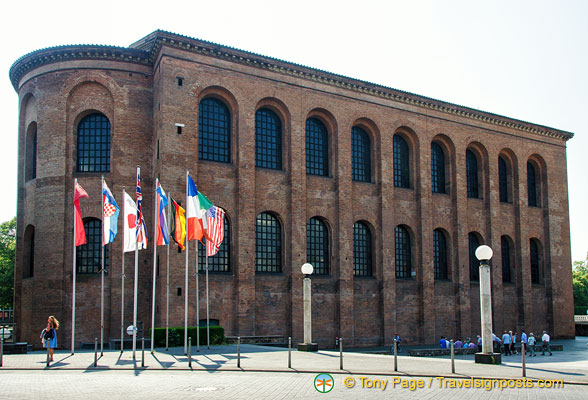Trier, a UNESCO World Heritage City, is Famous for its Roman Heritage and More:
Trier is one of Germany’s oldest city. The name Trier (Trèves in French) is believed to have been derived from the Celtic tribe of Treveri, who inhabited the lower valley of the Moselle from around 150 BC, but it is Trier’s Roman ruins and legacies that make this city a World Heritage site and a much sought after holiday destination.
Roman Trier
If you love history, Trier is a must-see destination. The city was founded by the Romans during the reign Emperor Augustus Caesar in 16 BC. Originally known as “Augusta Treverorum” (the Augustus City of the Treveri), Trier became a favoured city of Western emperors, and later the Bishops and Electors. Emperor Diocletian made Trier a Roman Imperial residence and capital city of the Western Roman Empire in AD 293. Constantine the Great was one of the most famous emperors here. He resided mostly in Trier and from here he undertook his struggle for sole rule of the Roman Empire. South of the Cathedral of St Peter was his Throne Hall (Konstantin-Basilika). Built in 310 AD as part of his palace complex, he would have received many imperial guests here. After Constantine the Great, other Roman emperors like Valentinian and his sons Gratian and Valentinian II all made Trier their Imperial residence from 367 to 390.
Under the various Roman emperors, Trier became an exceedingly wealthy city and grand monuments and city walls and gates were built. Of the four city gates only the monumental Porta Nigra remains. Urban developments such as the Römerbrücke (Roman bridge) across the Moselle was built – this is still a main access into the city. The amphitheatre, the Kaiserthermen (Imperial Bath) and the Barbarathermen (the so-called Barbara Baths) provided the city with leisure facilities.
Looking at the skyline of Trier, you will also see many church towers. When Constantine the Great converted to Christianity, grand churches were built in Trier, such as the Cathedral of St Peter and the Church of our Lady. All of these monuments give Trier its present-day status as a World Heritage city.
Trier after the Collapse of the Western Roman Empire
Trier was an important city even after the fall of the Western Roman Empire. In the 12th century, when the Trier archbishops were simultaneously Electors in the Holy Roman Empire, they made Trier the capital of their electoral state until its dissolution around 1800. After a brief period as a part of France, Trier became part of Prussia in 1814 and became a town of the Rhineland-Palatinate after the founding of the Federal Republic of Germany in 1949. Today Trier is located in the west of the state of Rhineland-Palatinate near the Luxembourg border.
Things to See and Do in Trier
With its World Heritage Site status, Trier is a sought after vacation destination and there is plenty to see and do in this town. In addition to its Roman heritage, there are many impressive buildings from medieval times such as the Hauptmarkt square with its market cross, the Steipe and the Red House.
Trier may be Germany’s oldest city, but it also has a very modern feel about it. It is a university town and being in the centre of the wine-growing area on the Moselle, Saar and Ruwer, there are many guided wine tours for the wine enthusiasts as well as opportunities for wine-tasting in town. For those looking for an active holiday, hiking and cycling in the Moselle valley are also popular activities.
Being located on the banks of the Moselle River, Trier has also become a popular stop for cruises on the Moselle River such as the Uniworld River Princess that we arrived on. On our brief river cruise stop here we saw many of the main attractions in Trier, but it would take more days to really enjoy what the city has to offer.
Where to Stay
There are a number of hotels around Porta Nigra Platz, such as the 4-star Hotel Roemischer Kaiser or the Schroeders zum Christophel hotel.
For Moselle River views, you couldn’t get closer than the Hotel Römerbrücke and Hotel Constantin near the historic Römerbrücke (Roman bridge). However, if you’re planning on staying at these budget hotels in summer, be aware that the rooms are not air-conditioned, and traffic noise could be a problem if you need to leave your windows open at night – bring ear plugs if you’re sensitive to noise. For the complete list of Trier hotels, see Here.
How to Get to Trier
By Train
There are direct trains from many German cities to Trier. The Trier train station is about 500m from Porta Nigra. You can easily travel to Trier in the modern InterCity trains, without changing trains. See the Deutsche Bahn website.
Regional Buses
There are nine bus companies that link Trier with nearby towns and cities as well as the outlying villages, including an express buses from Frankfurt Airport to Trier. For timetable and ticket prices see Here.
By Air
- Luxembourg Airport is 30 minutes from Trier by car. There are regular shuttle bus and train connections between Luxembourg and Trier.
- Frankfurt Main Airport is two hours from Trier by car. There is an express bus from Frankfurt Airport to Trier, or you can catch the train.
See the sights of Trier at Travelsignposts Trier photo gallery here.





 Take Better Digital Photos eBook
Take Better Digital Photos eBook Guerrilla Travel Photography eBook
Guerrilla Travel Photography eBook
Leave a Reply